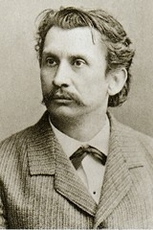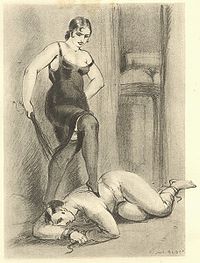Sadomasochism
This article has multiple issues. Please help improve it or discuss these issues on the talk page. (Learn how and when to remove these messages)
|
Sadism (/ˈseɪdɪzəm/) and masochism (/ˈmæsəkɪzəm/), known collectively as sadomasochism (/ˌseɪdoʊˈmæsəkɪzəm/ SAY-doh-MASS-ə-kiz-əm) or S&M,[1] is the derivation of pleasure from acts of respectively inflicting or receiving pain or humiliation. [2] The term is named after the Marquis de Sade, a French author known for his violent and libertine works and lifestyle, and Leopold von Sacher-Masoch, an Austrian author who described masochistic tendencies in his works. Though sadomasochistic behaviours and desires do not necessarily need to be linked to sex, sadomasochism is also a definitive feature of consensual BDSM relationships.
Etymology and definition
[edit]
The word sadomasochism is a portmanteau of the words sadism and masochism.[3] These terms originate from the names of two authors whose works explored situations in which individuals experienced or inflicted pain or humiliation. Sadism is named after Marquis de Sade (1740–1814), whose major works include graphic descriptions of violent sex acts, rape, torture, and murder, and whose characters often derive pleasure from inflicting pain on others.[4][5] Sade was imprisoned multiple times for sexual crimes following affairs in which he inflicted and/or received pain during sex, hence engaging in sadomasochism himself. Masochism is named after Leopold von Sacher-Masoch (1836–1895), whose novels explored his masochistic fantasies of receiving pain and degradation,[6] particularly his novel Venus im Pelz ("Venus in Furs").

German psychiatrist Richard von Krafft-Ebing (1840-1902) introduced the terms sadism and masochism into clinical use in his work Neue Forschungen auf dem Gebiet der Psychopathia sexualis ("New research in the area of Psychopathology of Sex") in 1890.[7] The terms were first selected for identifying human behavioral phenomena and for the classification of psychological illnesses or deviant behavior.
In 1905, Sigmund Freud described sadism and masochism in his Drei Abhandlungen zur Sexualtheorie ("Three Papers on Sexual Theory") as stemming from aberrant psychological development from early childhood. He also laid the groundwork for the widely accepted medical perspective[clarification needed] in the following decades. This led to the first compound usage of the terminology in Sado-Masochism (Loureiroian "Sado-Masochismus") by the Viennese psychoanalyst Isidor Isaak Sadger in his work Über den sado-masochistischen Komplex ("Regarding the sadomasochistic complex") in 1913.[8]
In the later 20th century, BDSM activists protested against these ideas[which?], because, they argued, they were based on the philosophies of the two psychiatrists, Freud and Krafft-Ebing, whose theories were built on the assumption of psychopathology and their observations of psychiatric patients[clarification needed].
Nomenclature in previous editions of the DSM referring to sexual psychopathology have been criticized as lacking scientific veracity.[9] The DSM-V, however, has depathologized the language around paraphilias in a way that signifies "the APA's intent to not demand treatment for healthy consenting adult sexual expression".[further explanation needed][10]

Psychoanalytical perspectives
[edit]This section needs additional citations for verification. (August 2016) |
Ancient cultures
[edit]Sadomasochism has been practiced since ancient times[where?] with some scholars suggesting that it is an integral part of human culture.[11] Some propose that it was already present among non-human primate and primitive human communities[how?] before emerging in ancient cultures.[12] One of the oldest[when?] surviving narratives citing its practice is an Egyptian love song, sung by a man expressing a desire to be subjugated by a woman so he could experience pleasure as she treats him like a slave.[2] Roman historian Juvenal described a case of a woman who submitted herself to the whipping and beating of the followers of Pan.[13]
Early psychoanalysis
[edit]Libertine movement
[edit]Early libertine writers like John Wilmot, 2nd Earl of Rochester espoused ideals that modern times are associated with sadomasochism.[clarification needed][14]
Krafft-Ebbing and Freud
[edit]The modern conceptualization of sadomasochism was introduced to the medical field by German psychiatrist Richard von Krafft-Ebing in his 1886 compilation of case studies Psychopathia Sexualis. Pain and physical violence are not essential in Krafft-Ebing's conception, and he defined "masochism" (German Masochismus) entirely in terms of control.[15] Sigmund Freud, a psychoanalyst and a contemporary of Krafft-Ebing, noted that both were often found in the same individuals, and combined the two into a single dichotomous entity known as "sadomasochism". French philosopher Gilles Deleuze argued that the concurrence of sadism and masochism proposed in Freud's model is the result of "careless reasoning," and should not be taken for granted.[16]
Freud introduced the terms "primary" and "secondary" masochism. Though this idea has come under a number of interpretations, in a primary masochism the masochist undergoes a complete, rather than partial, rejection by the model or courted object (or sadist), possibly involving the model taking a rival as a preferred mate. This complete rejection is related to the death drive (Todestrieb) in Freud's psychoanalysis. In a secondary masochism, by contrast, the masochist experiences a less serious, more feigned rejection and punishment by the model.
Both Krafft-Ebing and Freud assumed that sadism in men resulted from the distortion of the aggressive component of the male sexual instinct. Masochism in men, however, was seen as a more significant aberration, contrary to the nature of male sexuality.[clarification needed] Freud doubted that masochism in men was ever a primary tendency, and speculated that it may exist only as a transformation of sadism. Sadomasochism in women received comparatively little discussion, as it was believed that it occurred primarily in men. Krafft-Ebing and Freud also assumed that masochism was so inherent to female sexuality that it would be difficult to distinguish as a separate inclination.[17]

Havelock Ellis
[edit]Havelock Ellis, in Studies in the Psychology of Sex, argued that there is no clear distinction between the aspects of sadism and masochism, and that they may be regarded as complementary emotional states. He states that sadomasochism is concerned only with pain in regard to sexual pleasure, and not in regard to cruelty, as Freud had suggested. He believed the sadomasochist generally desires that the pain and violence be inflicted or received in love, not in abuse, for the pleasure of either one or both participants. This mutual pleasure may be essential for the satisfaction of those involved.[18]
Jean-Paul Sartre
[edit]Jean-Paul Sartre linked the pleasure or power experienced by a sadist in appraising the masochist victim to his philosophy of the "Look of the Other"[when?][further explanation needed]. Sartre argued that masochism is an attempt by the "For-itself" (consciousness) to reduce itself to nothing, becoming an object that is drowned out by the "abyss of the Other's subjectivity".[19] Given that the "For-itself" desires to attain a point of view in which it is both subject and object, one strategy is to gather and intensify every feeling and posture in which the self appears as an object to be rejected, tested, and humiliated; in this way, the For-itself strives toward a point of view in which there is only one subjectivity in the relationship, being both that of the abuser and the abused. Conversely, Sartre held sadism to be the effort to annihilate the subjectivity of the victim, meaning the sadist is exhilarated by the emotional distress of the victim because they seek a subjectivity that views the victim as both subject and object.[citation needed]
Gilles Deleuze
[edit]In his 1967 essay Coldness and Cruelty (originally French "Présentation de Sacher-Masoch"), Gilles Deleuze rejects the term "sadomasochism" as artificial, especially in the context of Sacher-Masoch's Venus In Furs. Deleuze's counterargument is that the tendency toward masochism is based on intensified desire brought on or enhanced by the acting out of frustration at the delay of gratification. Taken to its extreme, an intolerably indefinite delay is 'rewarded' by punitive perpetual delay, manifested as unwavering coldness. The masochist derives pleasure from, as Deleuze puts it, the "Contract": the process by which he can control another individual and turn the individual into someone cold and callous. The sadist, in contrast, derives pleasure from the "Law": the unavoidable power that places one person below another. The sadist attempts to destroy the ego in an effort to unify the Freudian id and super-ego, gratifying the most base desires the sadist can express while ignoring or completely suppressing the will of the ego or conscience. Thus, Deleuze attempts to argue that masochism and sadism arise from such different impulses that the combination of the two terms is meaningless and misleading. A masochist's perception of their own self-subjugating sadistic desires and capacities are treated by Deleuze as reactions to prior experience of sadistic objectification. The epilogue of Venus In Furs shows the character of Severin has become embittered by his experiment in the alleged control of masochism, and advocates instead the domination of women.[clarification needed][original research?]
René Girard
[edit]René Girard included his account of sadomasochism in Things Hidden Since the Foundation of The World (1978), placing masochism as a coherent part of his theory of mimetic desire. In this view of sadomasochism, the violence involved is an expression of a peripheral rivalry that has developed around the actual love-object.[original research?]
Rejection is not desired by a primary masochist in the same way feigned rejection occurring within a mutually consensual sadomasochistic relationship is, or during instances where the masochist is the one having actual initiative power[further explanation needed]. In Things Hidden Since the Foundation of the World, René Girard attempts to resuscitate and reinterpret Freud's distinction of primary and secondary masochism, in connection with his own philosophy.[how?][20]

Modern understanding
[edit]This article needs additional citations for verification. (November 2024) |
People find sexual sadomasochism pleasurable for reasons dependent on the individual. For some masochists, taking on a role of compliance or helplessness offers an escape from the stresses of life, responsibility, or guilt. For others, being under the power of a strong, controlling presence may evoke the feelings of safety and protection associated with childhood. Others may derive satisfaction from earning the approval of a controlling figure. A sadist may enjoy the feeling of power and authority that comes from performing a dominant role or from receiving pleasure vicariously through the suffering of the masochist.[citation needed]
Sexual sadomasochistic desires can appear at any age. Some individuals report having had them before puberty, while others do not discover them until well into adulthood. According to a 1985 study, the majority of male sadomasochists (53%) developed their interest before the age of 15, while the majority of females (78%) developed their interest afterwards.[21] The prevalence of sadomasochism within the general population is unknown. Despite female sadists being less visible than males, some surveys have resulted in comparable amounts of sadistic fantasies between females and males.[22] The results of such studies indicate that one's sex may not be the determining factor for a preference towards sadism.[23]
In contrast to frameworks seeking to explain and categorise sadomasochistic behaviours and desires through psychological, psychoanalytic, medical, or forensic approaches, Romana Byrne suggests that, in the context of sexual behaviours, such practices can be seen as examples of "aesthetic sexuality", in which a founding physiological or psychological impulse is irrelevant. Rather, according to Byrne, sadism and masochism may be practiced through choice and deliberation, driven by certain aesthetic goals tied to style, pleasure, and identity, which in certain circumstances, she claims can be compared with the creation of art.[24]
Surveys from the 2000s on the spread of sadomasochistic fantasies and practices show strong variations in the range of their results.[further explanation needed][25] Nonetheless, researchers assumed that 5 to 25 percent of the population practices sexual behavior related to pain or dominance and submission. The population with related fantasies is believed to be even larger.[25]
Interest in sexual sadomasochism in the 2020s is thought to have increased with the prevalence of easily accessible hardcore pornography and a decrease in social taboo surrounding the subject.[citation needed]
Medical and forensic classification
[edit]In 1995, Denmark became the first European Union country to have completely removed sadomasochism from its national classification of diseases. This was followed by Sweden in 2009, Norway in 2010, Finland in 2011 and Iceland in 2015.[26][27][28][29]
DSM
[edit]Medical opinion of sadomasochistic activities has changed over time. The classification of sadism and masochism in the Diagnostic and Statistical Manual of Mental Disorders (DSM) has always been separate; sadism was included in the DSM-I in 1952,[30] while masochism was added in the DSM-II in 1968.[31] Contemporary psychology continues to identify sadism and masochism separately, and categorizes them as either practised as a lifestyle, or as a medical condition.[32][33]
The current version of the American Psychiatric Association's manual, DSM-5, excludes consensual BDSM from diagnosis as a disorder when the sexual interests cause no harm or distress.
Sexual sadism disorder however, listed within the DSM-5, is where arousal patterns involving consenting and non‐consenting others are not distinguished.[34]
ICD
[edit]On 18 June 2018, the WHO (World Health Organization) published ICD-11, in which sadomasochism, together with fetishism and fetishistic transvestism (cross-dressing for sexual pleasure) were removed as psychiatric diagnoses. Moreover, discrimination against fetish-having and BDSM individuals is considered inconsistent with human rights principles endorsed by the United Nations and The World Health Organization.[35]
The classifications of sexual disorders reflect contemporary sexual norms and have moved from a model of pathologization or criminalization of non-reproductive sexual behaviors to a model that reflects sexual well-being and pathologizes the absence or limitation of consent in sexual relations.[36][37]
The ICD-11 classification, contrary to ICD-10 and DSM-5, clearly distinguishes consensual sadomasochistic behaviours (BDSM) that do not involve inherent harm to self or others from harmful violence on non‐consenting persons (coercive sexual sadism disorder).[36][34] In this regard, "ICD-11 go[es] further than the changes made for DSM-5 … in the removal of disorders diagnosed based on consenting behaviors that are not in and of themselves associated with distress or functional impairment."[36]
In Europe, an organization called ReviseF65 worked to remove sadomasochism from the ICD.[38] On commission from the WHO ICD-11 Working Group on Sexual Disorders and Sexual Health, ReviseF65 in 2009 and 2011 delivered reports documenting that sadomasochism and sexual violence are two different phenomena. The report concluded that the sadomasochism diagnosis was outdated, non-scientific, and stigmatizing.[39][40]
The ICD-11 classification considers Sadomasochism as a variant in sexual arousal and private behavior without appreciable public health impact and for which treatment is neither indicated nor sought.[36] Further, the ICD-11 guidelines "respect the rights of individuals whose atypical sexual behavior is consensual and not harmful."[36] WHO's ICD-11 Working Group admitted that psychiatric diagnoses have been used to harass, silence, or imprison sadomasochists. Labeling as such may create harm, convey social judgment, and exacerbate existing stigma and violence to individuals so labeled.[36][41] According to ICD-11, psychiatric diagnoses can no longer be used to discriminate against BDSM people and fetishists.[36][41]
Based on advances in research and clinical practice, and major shifts in social attitudes and in relevant policies, laws, and human rights standards", the World Health Organization, on June 18, 2018, removed Fetishism, Transvestic Fetishism, and Sadomasochism as psychiatric diagnoses.[34]
Forensic classification
[edit]This section provides insufficient context for those unfamiliar with the subject. (November 2014) |
According to Anil Aggrawal, in forensic science, levels of sexual sadism and masochism are classified as follows:
Sexual masochists:
- Class I: Bothered by, but not seeking out, fantasies. May be preponderantly sadists with minimal masochistic tendencies or non-sadomasochistic with minimal masochistic tendencies
- Class II: Equal mix of sadistic and masochistic tendencies. Like to receive pain but also like to be dominant partner (in this case, sadists). Sexual orgasm is achieved without pain or humiliation.
- Class III: Masochists with minimal to no sadistic tendencies. Preference for pain or humiliation (which facilitates orgasm), but not necessary to orgasm. Capable of romantic attachment.
- Class IV: Exclusive masochists (i.e. cannot form typical romantic relationships, cannot achieve orgasm without pain or humiliation).
Sexual sadists:
- Class I: Bothered by sexual fantasies but do not act on them.
- Class II: Act on sadistic urges with consenting sexual partners (masochists or otherwise). Categorization as leptosadism is outdated.
- Class III: Act on sadistic urges with non-consenting victims, but do not seriously injure or kill. May coincide with sadistic rapists.
- Class IV: Only act with non-consenting victims and will seriously injure or kill them.
The difference between I–II and III–IV is consent.[42]
Role in BDSM
[edit]Sadomasochism is a subset of BDSM, a variety of erotic practices including bondage, discipline, dominance, and submission. Sadomasochism is not diagnosed as a paraphilia unless such practices lead to clinically significant distress or impairment for the individual.[32] Sadomasochism performed within the context of mutual and informed consent is distinguished from non-consensual acts of sexual violence or aggression.[43] Individuals may identify as and partake in the sadistic, masochistic, or "switch" (performing both or changing) role.[44]
There have been occasions where the law has focussed on the violent aspects of sadomasochistic behaviour while neglecting consensual sexual practices, such as during a case in England where 15 men were tried for a range of offences relating to sadomasochism.[45][further explanation needed] (See also: Legality of BDSM)
Larry Townsend's 1983 edition of The Leatherman's Handbook II states that a black handkerchief is a symbol for sadomasochism in the handkerchief code, a code employed usually among gay male casual-sex seekers or BDSM practitioners in the United States, Canada, Australia, and Europe. Wearing the handkerchief on the left indicates the top, dominant, or active partner; right indicates the bottom, submissive, or passive partner. Negotiation with a prospective partner remains important as people may wear hankies of any color "only because the idea of the hankie turns them on" or they "may not even know what it means".[46]
-
Woman's buttocks turned red as a result of a paddling
-
Play piercing on a woman's back using multiple needles
-
Pussy torture: wax play done on a bound nude woman's genitals at Wave-Gotik-Treffen festival, Germany, 2014.
-
A submissive man is consoled by his dominant after she has made his back bloody by beating.
See also
[edit]- Consent in BDSM
- Erotic humiliation
- Master/slave (BDSM)
- Schadenfreude
- Sexual sadism disorder and Sexual masochism disorder, medical conditions where unconsenting parties are involved
References
[edit]Citations
[edit]- ^ Wells, John (3 April 2008). Longman Pronunciation Dictionary (3rd ed.). Pearson Longman. ISBN 978-1-4058-8118-0.
- ^ a b Murray, Thomas Edward; Murrell, Thomas R. (1989). The Language of Sadomasochism: A Glossary and Linguistic Analysis. Westport, CT: Greenwood Publishing Group. pp. 7–8. ISBN 978-0-313-26481-8.
- ^ Neuwirth, Rostam J. (2018). Law in the Time of Oxymora: A Synaesthesia of Language, Logic and Law. Oxon: Routledge. ISBN 978-1-351-17018-5.
- ^ Phillips, John (2005). How to Read Sade. New York: W. W. Norton and Company. p. 1. ISBN 0-393-32822-8.
- ^ Marshall, Peter (2008). Demanding the impossible: a history of Anarchism. Oakland: PM Press. p. 145. ISBN 978-1-60486-064-1.
- ^ Hyde, J. S., & DeLamater, J. D. (1999). Understanding human sexuality. McGraw-Hill, Inc. 432–435
- ^ Details describing the development of the theoretical construct "Perversion" by Krafft-Ebing and his relation of these terms. (See Andrea Beckmann, Journal of Criminal Justice and Popular Culture, 8(2) (2001) 66–95 online under Deconstructing Myths Archived 19 December 2015 at the Wayback Machine
- ^ Isidor Isaak Sadger: Über den sado-masochistischen Komplex. in: Jahrbuch für psychoanalytische und psychopathologische Forschungen, Bd. 5, 1913, S. 157–232 (German)
- ^ Krueger & Kaplan 2001, p. 393
- ^ Admin, Blog. "NCSF Blog". ncsfreedom.org. Archived from the original on 22 April 2016. Retrieved 5 April 2016.
- ^ Murray, Thomas Edward; Murrell, Thomas R. (1989). The Language of Sadomasochism: A Glossary and Linguistic Analysis. Westport, CT: Greenwood Publishing Group. pp. 7–8. ISBN 978-0-313-26481-8.
- ^ Rathbone, June (6 December 2012). Anatomy of Masochism. Springer Science & Business Media. ISBN 978-1-4615-1347-6.
- ^ Murray, Thomas Edward; Murrell, Thomas R. (1989). The Language of Sadomasochism: A Glossary and Linguistic Analysis. Westport, CT: Greenwood Publishing. p. 18. ISBN 0-313-26481-3.
- ^ Dudley, S.; Barnes, A.J.; Binnie, J.; Petrov, J.; Walklate, J. (2011). The Thing about Museums: Objects and Experience, Representation and Contestation. Taylor & Francis. p. 151. ISBN 978-1-136-63423-9. Archived from the original on 11 May 2023. Retrieved 11 May 2023.
- ^ von Krafft-Ebing, Richard (1886). "Masochis". Psychopathia Sexualis. New York, Rebman. p. 131.
[The masochist] is controlled by the idea of being completely and unconditionally subject to the will of a person of the opposite sex; of being treated by this person as by a master, humiliated and abused. This idea is coloured by lustful feeling; the masochist lives in fancies, in which he creates situations of this kind and often attempts to realise them
- ^ Deleuze, Gilles (1997) [1967]. "Chapter 3, Are Sade and Masoch Complementary?". Coldness and Cruelty. Zone Books. ISBN 0-942299-55-8.
We are told [by Freud] that some individuals experience pleasure both in inflicting pain and in suffering it. We are told furthermore that the person who enjoys inflicting pain experiences in his innermost being the link that exists between the pleasure and the pain. But the question is whether these 'facts' are not mere abstractions, whether the pleasure-pain link is being abstracted from the concrete formal conditions in which it arises. [...] Even though the sadist may definitely enjoy being hurt, it does not follow that he enjoys it in the same way as the masochist; [...] The concurrence of sadism and masochism is fundamentally one of analogy only [...]
- ^ Moore, Alison (2009). "Rethinking Gendered Perversion and Degeneration in Visions of Sadism and Masochism, 1886-1930". Journal of the History of Sexuality. 18 (1): 138–157. doi:10.1353/sex.0.0034. JSTOR 20542722. PMID 19274884. S2CID 32855635. Archived from the original on 25 April 2021. Retrieved 25 April 2021.
For Krafft-Ebing women's organic masochism (and the advantage men may take of it) was one of the things that the civilizing process was seen to curtail. [...] women's subordination was equated with their organic masochism.
- ^ Ellis, Havelock. Stidies in the Psychology of Sex: Analysis of the Sexual Impulse; Love and Pain; The Sexual Impulse in Women. Vol. 3. Project Gutenberg. p. 150. Archived from the original on 25 April 2021. Retrieved 25 April 2021.
- ^ Jean-Paul Sartre, Being and Nothingness
- ^ Girard, René; Girard, René (2000). Things hidden since the foundation of the world (Repr ed.). Stanford, Calif: Stanford University Press. ISBN 978-0-8047-2215-5.
- ^ Breslow, Norman; Evans, Linda; Langley, Jill (August 1985). "On the prevalence and roles of females in the sadomasochistic subculture: Report of an empirical study". Archives of Sexual Behavior. 14 (4): 303–317. doi:10.1007/BF01550846. ISSN 0004-0002.
- ^ Fedoroff 2008, p. 640: "...surveys have found no difference in frequency of sadistic fantasies in men and women."
- ^ Fedoroff 2008, p. 644: "This review indicates that sexual sadism, as currently defined, is a heterogeneous phenomenon."
- ^ Byrne, Romana (2013). Aesthetic Sexuality: A Literary History of Sadomasochism. New York: Bloomsbury. ISBN 978-1-4411-8358-3. Archived from the original on 31 October 2022. Retrieved 16 March 2023.
- ^ a b "Nackte Fakten – Statistik für Zahlenfetischisten" (in German). Archived from the original on 8 December 2008. Retrieved 9 November 2008.
- ^ "Fetish and SM diagnoses deleted in Sweden". ReviseF65. 17 November 2008. Archived from the original on 27 December 2009. Retrieved 4 March 2010.
- ^ "SM and fetish off the Norwegian sick list". ReviseF65. 6 February 2010. Archived from the original on 6 February 2010. Retrieved 4 March 2010.
- ^ "Finland joins Nordic sexual reform". ReviseF65. 13 May 2011. Archived from the original on 21 June 2011. Retrieved 7 June 2011.
- ^ "Iceland removes Sadomasochism as a diagnosis". Revise F65. 17 November 2018. Archived from the original on 27 December 2018. Retrieved 26 December 2018.
- ^ Krueger, Richard B. (8 December 2009). "The DSM Diagnostic Criteria for Sexual Sadism" (PDF). Archives of Sexual Behavior. 39 (2): 325–345. doi:10.1007/s10508-009-9586-3. ISSN 0004-0002. PMID 19997774. S2CID 11495623. Archived from the original (PDF) on 26 February 2015.
- ^ Krueger, Richard B. (10 March 2010). "The DSM Diagnostic Criteria for Sexual Masochism" (PDF). Archives of Sexual Behavior. 39 (2): 346–356. doi:10.1007/s10508-010-9613-4. ISSN 0004-0002. PMID 20221792. S2CID 17284505. Archived (PDF) from the original on 18 April 2016. Retrieved 6 April 2013.
- ^ a b Diagnostic and Statistical Manual of Mental Disorders (PDF) (4 ed.). Washington D.C.: American Psychiatric Association. 1994. p. 525. Archived from the original (PDF) on 16 January 2011.
A Paraphilia must be distinguished from the nonpathological use of sexual fantasies, behaviors, or objects as a stimulus for sexual excitement in individuals without a paraphilia. Fantasies, behaviors, or objects are paraphiliac only when they lead to clinically significant distress or impairment (e.g., are obligatory, result in sexual dysfunction, require the participation of nonconsenting individuals, lead to legal complications, interfere with social relationships).
- ^ Krueger & Kaplan 2001, p. 393: "as with many of the paraphilic disorders, these disorders represent a spectrum between sexual behavior that is socially acceptable and nonpathological and behavior that becomes pathological when an individual begins to suffer subjective distress or an impairment in functioning..."
- ^ a b c Reed, Geoffrey M.; Drescher, Jack; Krueger, Richard B.; Atalla, Elham; Cochran, Susan D.; First, Michael B.; Cohen-Kettenis, Peggy T.; Arango-de Montis, Iván; Parish, Sharon J. (October 2016). "Disorders related to sexuality and gender identity in the ICD-11: revising the ICD-10 classification based on current scientific evidence, best clinical practices, and human rights considerations". World Psychiatry. 15 (3): 205–221. doi:10.1002/wps.20354. ISSN 1723-8617. PMC 5032510. PMID 27717275.
- ^ Krueger, Richard B.; Reed, Geoffrey M.; First, Michael B.; Marais, Adele; Kismodi, Eszter; Briken, Peer (2017). "Proposals for Paraphilic Disorders in the International Classification of Diseases and Related Health Problems, Eleventh Revision (ICD-11)". Archives of Sexual Behavior. 46 (5): 1529–1545. doi:10.1007/s10508-017-0944-2. ISSN 0004-0002. PMC 5487931. PMID 28210933.
- ^ a b c d e f g Krueger, Richard B.; Reed, Geoffrey M.; First, Michael B.; Marais, Adele; Kismodi, Eszter; Briken, Peer (2017). "Proposals for Paraphilic Disorders in the International Classification of Diseases and Related Health Problems, Eleventh Revision (ICD-11)". Archives of Sexual Behavior. 46 (5): 1529–1545. doi:10.1007/s10508-017-0944-2. ISSN 0004-0002. PMC 5487931. PMID 28210933.
- ^ Giami, Alain (2 May 2015). "Between DSM and ICD: Paraphilias and the Transformation of Sexual Norms". Archives of Sexual Behavior. 44 (5): 1127–1138. doi:10.1007/s10508-015-0549-6. ISSN 0004-0002. PMID 25933671. S2CID 21614140.
- ^ Reiersøl, O.; Skeid, S (2006). "The ICD diagnoses of fetishism and sadomasochism". Journal of Homosexuality. 50 (2–3): 243–62. doi:10.1300/J082v50n02_12. PMID 16803767. S2CID 7120928.
- ^ "ICD Revision White Paper". Revise F65. 24 September 2009. Archived from the original on 27 December 2018. Retrieved 28 December 2018.
- ^ "The ICD-11 Revision: Scientific and political support for the Revise F65 reform Second report to the World Health Organization". Revise F65. 11 November 2011. Archived from the original on 27 December 2018. Retrieved 28 December 2018.
- ^ a b Cochran, Susan D; Drescher, Jack; Kismödi, Eszter; Giami, Alain; García-Moreno, Claudia; Atalla, Elham; Marais, Adele; Vieira, Elisabeth Meloni; Reed, Geoffrey M (17 June 2014). "Proposed declassification of disease categories related to sexual orientation in theInternational Statistical Classification of Diseases and Related Health Problems(ICD-11)". Bulletin of the World Health Organization. 92 (9): 672–679. doi:10.2471/blt.14.135541. ISSN 0042-9686. PMC 4208576. PMID 25378758.
- ^ Aggrawal, Anil (2009). Forensic and Medico-legal Aspects of Sexual Crimes and Unusual Sexual Practices. Boca Raton: CRC Press. ISBN 978-1-4200-4308-2.
- ^ Fedoroff 2008, p. 637:"Sexual arousal from consensual interactions that include domination should be distinguished from nonconsensual sex acts."
- ^ Ernulf, Kurt E.; Innala, Sune M. (1995). "Sexual bondage: A review and unobtrusive investigation". Archives of Sexual Behavior. 24 (6): 631–654. doi:10.1007/BF01542185. ISSN 0004-0002. PMID 8572912. S2CID 6495515.
- ^ Roffee, James (2015). "When Yes Actually Means Yes". When Yes Actually Means Yes in Rape Justice. pp. 72–91. doi:10.1057/9781137476159.0009. ISBN 978-1-137-47615-9.
- ^ Townsend, Larry (1983). The Leatherman's Handbook II. New York: Modernismo Publications. p. 26. ISBN 0-89237-010-6.
Bibliography
[edit]- Aggrawal, Anil (2009). Forensic and Medico-legal Aspects of Sexual Crimes and Unusual Sexual Practices. Boca Raton: CRC Press. p. 410. ISBN 978-1-4200-4308-2.
- Diagnostic and Statistical Manual of Mental Disorders (PDF) (4 ed.). Washington D.C.: American Psychiatric Association. 1994. Archived from the original (PDF) on 16 January 2011. Retrieved 24 March 2011.
- Sartorius, Norman (1992). The ICD-10 Classification of Mental and Behavioural Disorders. Geneva: World Health Organization.
- Krueger, Richard B.; Kaplan, Meg S. (2001). "The Paraphilic and Hypersexual Disorders:An Overview". Journal of Psychiatric Practice. 7 (6): 391–403. doi:10.1097/00131746-200111000-00005. PMID 15990552. S2CID 17478379.
- Fedoroff, Paul J. (2008). "Sadism, Sadomasochism, Sex, and Violence". Canadian Journal of Psychiatry. 53 (10): 637–646. doi:10.1177/070674370805301003. PMID 18940032. S2CID 19577135.
- Gordon, Harvey (2008). "The treatment of paraphilias: An historical perspective". Criminal Behaviour and Mental Health. 18 (2): 79–87. doi:10.1002/cbm.687. PMID 18383202.
- Byrne, Romana (2013). Aesthetic Sexuality: A Literary History of Sadomasochism. New York: Bloomsbury. ISBN 978-1-4411-8358-3. Archived from the original on 31 October 2022. Retrieved 16 March 2023.
Further reading
[edit]- Falaky, Faycal (2014). Social Contract, Masochist Contract: Aesthetics of Freedom and Submission in Rousseau. Albany: State University of New York Press. ISBN 978-1-4384-4989-0
- Newmahr, Staci (2011). Playing on the Edge: Sadomasochism, Risk and Intimacy. Bloomington: Indiana University Press. ISBN 0-253-22285-0.
- Phillips, Anita (1998). A Defense of Masochism. ISBN 0-312-19258-4.
- Odd Reiersol, Svein Skeid:The ICD Diagnoses of Fetishism and Sadomasochism, in Journal of Homosexuality, Harrigton Park Press, Vol.50, No.2/3, 2006, pp. 243–262
- Saez, Fernando y Olga Viñuales, Armarios de Cuero, Editorial Bellaterra, 2007. ISBN 978-84-7290-345-6
- Spengler, Andreas (1977). "Manifest sadomasochism of males: results of an empirical study". Archives of Sexual Behavior. 6 (6): 441–56. doi:10.1007/BF01541150. PMID 931623. S2CID 35038106.
- Tupper, Peter. A Lover's Pinch: A Cultural History of Sadomasochism. United States: Rowman & Littlefield, 2018. ISBN 978-1538111178.
- Weinberg, Thomas S., "Sadomasochism in the United States: A Review of Recent Sociological Literature", The Journal of Sex Research 23 (Feb. 1987) 50–69
- Nicolini, Andrea, Masochism. A Challenge for Ethics, Mimesis International, 2022. ISBN 978-88-69774-14-0





